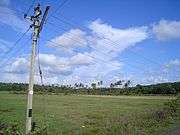Saligao
| Saligão Sallganv / साळगांव | |
|---|---|
| village | |
 Saligão  Saligão Location in Goa, India | |
| Coordinates: 15°33′N 73°46′E / 15.55°N 73.77°ECoordinates: 15°33′N 73°46′E / 15.55°N 73.77°E | |
| Country |
|
| State | Goa |
| District | North Goa |
| Elevation | 9 m (30 ft) |
| Population (2001) | |
| • Total | 5,553 |
| Languages | |
| • Official | Konkani |
| Time zone | IST (UTC+5:30) |
| Vehicle registration | GA |
| Website |
goa |
Saligão ([saːɭɡãːw])(Marathi/Konkani- साळगाव) is a census town in North Goa district in the Indian state of Goa. It is surrounded by the villages of Porvorim, Parra, Guirim, Sangolda, Pilerne, Candolim, Calangute and Nagoa and is in Bardez Taluka of Goa. It is 10 km from Panjim the capital of Goa, 6 km from Mapusa the capital of Bardez Taluka, and 3 km from the Calangute beach.
Geography
Saligão is located at 15°33′N 73°46′E / 15.55°N 73.77°E.[1] It has an average elevation of 9 metres (30 feet).
Demographics
As of 2001 India census,[2] Saligão had a population of 5553. Males constitute 51% of the population and females 49%. Saligão has an average literacy rate of 82%, higher than the national average of 59.5%: male literacy is 87%, and female literacy is 76%. In Saligão, 8% of the population is under 6 years of age.
Places of interest
- Mater Dei, one of Goa's first English language schools, at Bairo Alto. Started as St. Mary's in 1900, the name was later changed to Mater Dei in 1909.

- Lourdes Convent High School at Sonarbhat
- Government Middle School at the CHOGM Road Crossing.
- Bank of India at the Saligão market.
- Pirna Urban Cooperative Bank, near the Saligão Super Market.
- Florentine Bar and Restaurant at Piqueno Morod, a small outlet known for its chicken cafreal dish.
- Samrat Hotel, a restaurant alongside the CHOGM road, known for its bhaji (vegetable-based) preparations.
- Leela Communications, at the Saligão market.
- Mahambre stores(General and Liquor store)
- Cherry Fernandes' play-school at D'Mello Vaddo.(closed)
- Tiny Steps play-school at Abreo Vaddo.
- Krist Raj Bhavan, home for the aged, run by the Franciscan Missionaries of Christ the King sisters.
- Mãe de Deus home for the aged, run by the Franciscan Missionaries of Christ the King sisters.
- Mãe de Deus Parish Church built in 1873.
- Hindu temples including Sharvani (near the Saligão spring, Salmona), Dattatriya (at the Seminary Hill, Sonarbhat), Laxmi Narayan (near market area) and Vittal temple (near the border with Sangolda).
- Saligão Medical Centre, near the Parish Church. For now, it has a doctor (General Practitioner) only in the mornings. Diagnostic and other facilities are planned.
Village issues
In recent years, Saligão, which is just outside the North Goa beach-belt, has seen significant concerns over the large-scale sale of ground-water from a number of wells in the village, particularly at Donvaddo. There has also been concern raised by villagers over the dumping of garbage from the coastal belt on the hillock atop the village, partly on village lands and partly on land belonging to the Calangute comunidade but very close (and overlooking) the village. On December 12, 2002, a writ petition was filed over this issue in the Goa bench of the High Court of Bombay.
The petition challenged the selection of a garbage disposal site on the top of Saligão plateau, in the midst of a social forest plantation raised by the Goa government's Forest Department. It argued that the decision to locate the disposal site in this "inappropriate area" was made without following the procedures established by law, particularly the provision of Municipal Solid Waste Rules, 2000 issued under provisions of the Environment Protection Act, 1986. "The location is bound to have grievous consequences for the environment, health and water supplies," the petition filed by green lawyer Norma Alvares of the Goa Foundation argued.
On the groundwater issue, in May 2002, a study titled "Saligao's water crisis and commercial groundwater extraction" was released. Its summary said: "Extraction of groundwater for commercial sale outside the village has risen sharply in the last five years, to a level of up to 435,000 litres per day. Groundwater levels are falling, and wells for household use and for irrigating farmland are running dry in some parts of Saligao, although other parts of the village are unaffected. The problem is very serious for household wells in Don Vaddo and parts of Sonarbhat, and for farmers in Mollembhat. Enough consumers are suffering serious problems to merit the SCCC (Saligao Civic and Consumers' Cell) taking up commercial groundwater extraction as a community issue."
It noted that more than half of 28 household wells surveyed in Don Vaddo and Sonarbhat went dry in April/May 2001, a normal monsoon year. At least 138 consumers depend on these wells. Falling water levels in this area have coincided with a very rapid increase in commercial extraction from the local well.
References
- ↑ Falling Rain Genomics, Inc -Saligão
- ↑ "Census of India 2001: Data from the 2001 Census, including cities, villages and towns (Provisional)". Census Commission of India. Archived from the original on 2004-06-16. Retrieved 2008-11-01.
| ||||||||||||||
| Images from Saligao, Goa, India |
External links
| Wikimedia Commons has media related to Saligao. |






